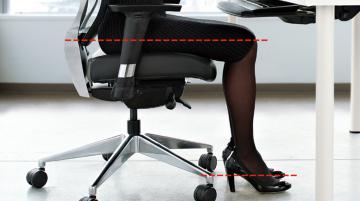Because you weren't designed to sit, we design seating solutions that help you to 'sit fit'.
The most common workplace injuries can happen while you're sitting down. We're not meant to be sedentary creatures, and prolonged sitting can result in back pain and muscular skeletal disorders (MSDs). The good news is that setting up an ergonomic workstation doesn't have to be complicated – and it's inexpensive compared to managing a worker's compensation claim and dealing with lost productivity. Healthy posture all starts with what you decide to sit yourself on.
THE KEY TO KEYING
Using a keyboard tray to help prevent wrist pain and repetitive strain injuries. While keying, keep your arms at right angles (aim for 90 degrees) and close to your body. Your wrists should be straight so you don't see any wrinkles. Keep your mouse close to the keyboard - preferably on a mousing platform - to minimize reaching.

MONITORING YOUR POSTURE
Your monitor height keeps your back straight and your head up, which is crucial to avoiding neck strain and injuries. Align your monitor so it's centered between your shoulder blades and positioned about an arm's length away from your face. The height should be so that the top line of text you're reviewing is at or just below eye level.
TIPS FOR SITTING SMART AND STAYING PRODUCTIVE

SEAT HEIGHT
Raise or lower your seat so your thighs are parallel to the floor and your feet are flat on the floor, or on a footrest.

SEAT DEPTH
Adjust the depth of the seat pan so you can fit your fist between the back of your knees and the front of the seat.

BACKREST
Adjust the height of your backrest so that the lumbar support on the chair supports the curve of your lower back.

LOCK IT IN
During focused tasks, lock the back in position. During alternate tasks (moving with your chair) unlock it to lean back.
